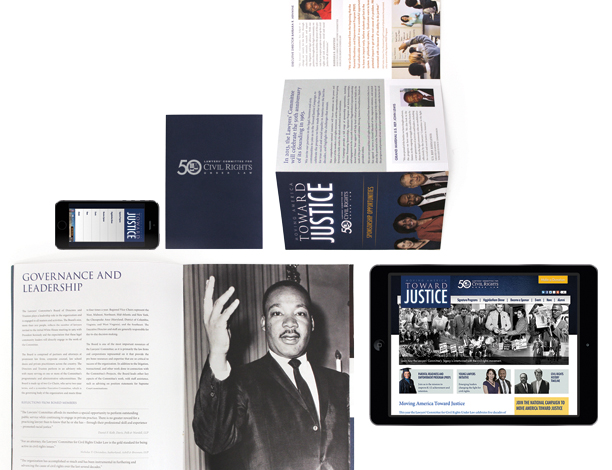How to Build (or Rebuild) a Nonprofit Identity by Christine Batta of SW Creatives

Your brand is made up of much more than just a logo, as shown by the website, brochure, and other print collateral that we created for the Lawyers’ Committee’s 50th Anniversary Toward Justice Campaign below.
By Christine Batta, Designer, SW Creatives, Associate Member
A lot of people associate “nonprofit identity” with a logo and/or other related visual elements. Those are certainly important parts of the mix, but they don’t make up the whole of your nonprofit branding efforts. In fact, beginning with those elements is something we might actually consider to be a backwards approach.
The reason is simple: Your logo’s individual components should be the result of thoughts you have about your identity, not the guiding force behind them. To see why that distinction is so important, consider some of the major steps we might follow in helping to build or rebuild a nonprofit identity:
1. CONSIDER YOUR ORGANIZATION’S PERSONALITY AND MISSION.
What is your group’s real goal, and how does your structure, mission, or personality separate you from other nonprofits? These are questions you definitely want to answer before you begin to map out an identity for your organization.
2. THINK ABOUT HOW THOSE ELEMENTS NEED TO BE CONVEYED TO THE PUBLIC.
In other words, with a sense of “who you are” firmly in mind, how do you want to be perceived by the public? What impression do you want them to have? This seems like a simple question, but it’s one that can affect everything from colors and fonts to slogans and mission statements.
3. BRAINSTORM FUTURE COMMUNICATIONS AND CAMPAIGNS.
Next, it’s time to imagine how your nonprofit might interact with the public in the future. Envision websites, press releases, fundraising campaigns, and so on. What sorts of identity pieces will you need, and how can they stay consistent with the goals you’ve already identified?
4. PUT VISUAL AND WRITTEN PIECES OF THE IDENTITY TOGETHER.
At this point, you should know what your organization is all about, and what kinds of messages you want to transmit, as well as the impressions you want to give to others. Now your creative team can start to put together logos and statements that are in line with those ideas.
5. HAVE A PLAN FOR FUTURE GROWTH AND WITHIN YOUR BRAND OR IDENTITY.
Remember that nonprofit identities are living, breathing things. Yours is going to change over time, and imagining that change ahead of time – and possibly guiding it along the way – is a great way to think about how your identity might shift as your overall mission does in the future.
You’ll notice that devising a logo isn’t at the top of the list. By taking a more nuanced approach to developing an identity for your nonprofit, we can ensure that all the visual pieces end up in sync with your bigger goals. That might not be the fastest way to develop an identity for your organization, but it is the one you’ll be glad you followed later.
For the best in nonprofit branding and marketing, get in touch with SW Creatives today.
Connect with Maryland Nonprofits on Facebook, Twitter, LinkedIn, and Google+, tell us what you think and what kind of topics you would like to see more of on our blog.
